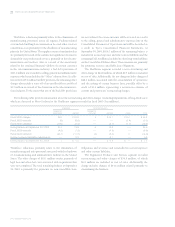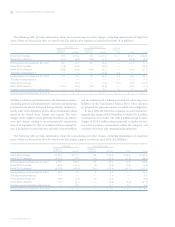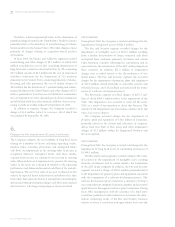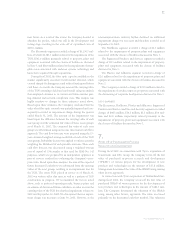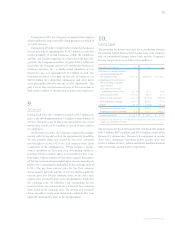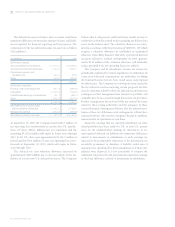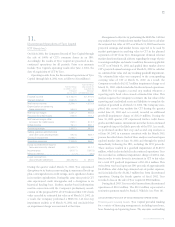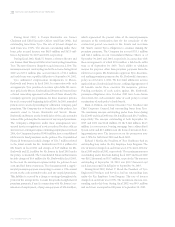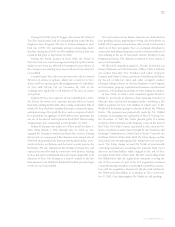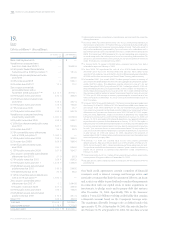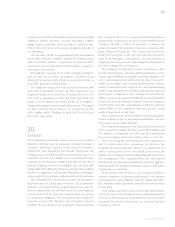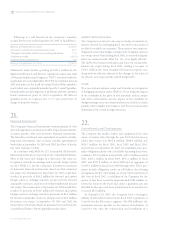ADT 2003 Annual Report Download - page 98
Download and view the complete annual report
Please find page 98 of the 2003 ADT annual report below. You can navigate through the pages in the report by either clicking on the pages listed below, or by using the keyword search tool below to find specific information within the annual report.
96
on loans and leases were referred to as finance receivables.
Financing and leasing assets consisted of finance receivables,
finance receivables held for sale, net book value of operating
lease equipment and certain investments.
At the time of designation for sale, securitization or syndica-
tion, assets were classified as finance receivables held for sale. These
assets were carried at the lower of aggregate cost or market value.
Lease Financing Direct financing leases were recorded at the
aggregate future minimum lease payments plus estimated
residual values less unearned finance income. Operating lease
equipment was carried at cost less accumulated depreciation and
was depreciated to estimated residual value using the straight-
line method over the lease term or projected economic life of
the asset. Equipment acquired in satisfaction of loans and sub-
sequently placed on operating lease was recorded at the lower
of carrying value or estimated fair value when acquired. Lease
receivables included leveraged leases, for which a major portion
of the funding was provided by third-party lenders on a non-
recourse basis, with Tyco Capital providing the balance and
acquiring title to the property. Leveraged leases were recorded
at the aggregate value of future minimum lease payments plus
estimated residual value, less nonrecourse third-party debt and
unearned finance income. Management performed periodic
reviews of the estimated residual values with impairment, other
than temporary, recognized in the appropriate period.
Reserve for Credit Losses on Finance Receivables The reserve
for credit losses was periodically reviewed for adequacy consid-
ering economic conditions, collateral values and credit quality
indicators, including historical and expected charge-off experi-
ence and levels of past due loans and non-performing assets.
Changes in economic conditions or other events affecting
specific obligors or industries may have necessitated additions
or deductions to the reserve for credit losses.
Charge-off of Finance Receivables Finance receivables were
reviewed periodically to determine the probability of loss.
Charge-offs were taken after considering such factors as the
borrower’s financial condition and the value of underlying
collateral and guarantees (including recourse to dealers and
manufacturers). Such charge-offs were deducted from the carry-
ing value of the related finance receivables. To the extent that an
unrecovered balance remained due, a final charge-off was taken
at the time collection efforts were no longer deemed useful.
Charge-offs were recorded on consumer and certain small ticket
commercial finance receivables beginning at 180 days of con-
tractual delinquency based upon historical loss severity.
Impaired Loans Impaired loans included primarily large loans
that were placed on non-accrual status or any troubled debt
restructuring. Loan impairment was defined as any shortfall
between the estimated value and the recorded investment in the
loan, with the estimated value determined using the fair value
of the collateral, if the loan was collateral dependent, or the
present value of expected future cash flows discounted at the
loan’s effective interest rate.
Securitizations Pools of assets were originated and sold to
independent trusts which, in turn, issued securities to investors
backed by the asset pools. Tyco Capital retained the servicing
rights and participated in certain cash flows from the pools.
The present value of expected net cash flows that exceeded the
estimated cost of servicing was recorded at the time of sale as a
“retained interest.” Subsequent to the recording of retained
interests, Tyco Capital reviewed such values on an asset by asset
basis at least as often as quarterly. Fair values of retained interests
were calculated utilizing current and anticipated credit losses,
prepayment speeds and discount rates and were then compared
to the respective carrying values. Losses, representing the excess
of carrying value over estimated current fair market value, were
recorded as impairments and were recognized as a charge to
operations. Unrealized gains were not credited to earnings but
were reflected in shareholders’ equity as part of other compre-
hensive income.
Finance income Includes interest on loans, the accretion of
income on direct financing leases, and rents on operating leases.
Related origination and other nonrefundable fees and direct
origination costs were deferred and amortized as an adjustment
of finance income over the contractual life of the transactions.
Income on finance receivables other than leveraged leases was
recognized on an accrual basis commencing in the month of
origination using methods that generally approximated the
interest method. Leveraged lease income was recognized on a
basis calculated to achieve a constant after-tax rate of return for
periods in which Tyco Capital had a positive investment in the
transaction, net of related deferred tax liabilities. Rental income
on operating leases was recognized on an accrual basis.
The accrual of finance income on commercial and consumer
finance receivables was generally suspended and an account
was placed on non-accrual status when payment of principal or
interest was contractually delinquent for 90 days or more, or
earlier when, in the opinion of management, full collection of
all principal and interest due was doubtful.
Financial Instruments See the Company’s discussion of signifi-
cant accounting policies included in Note 1 for information
related to financial instruments. Additionally, Tyco Capital had
derivatives, which were designated as a cash flow hedge. If a
TYCO INTERNATIONAL LTD.
Notes to Consolidated Financial Statements


